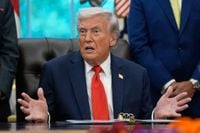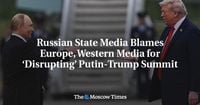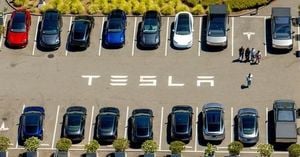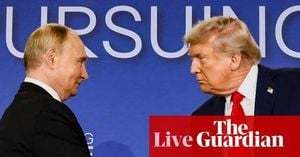Plans for a high-stakes summit between U.S. President Donald Trump and Russian President Vladimir Putin in Budapest have collapsed, dashing hopes for a swift resolution to the grinding 42-month war between Russia and Ukraine. The breakdown came after Trump floated a new ceasefire proposal, only to face immediate resistance from the Kremlin and growing frustration among allies and adversaries alike.
Just days ago, anticipation was building for a face-to-face meeting between the two leaders in Hungary—a potential turning point in the largest and deadliest European conflict since World War II. But on Tuesday, October 21, 2025, Trump signaled the talks were off, telling reporters at the White House, “I don’t want to have a wasted meeting. I don’t want to have a waste of time, so I’ll see what happens.” According to Reuters, this abrupt announcement followed a weekend of tense back-and-forth, with both sides digging in their heels over the terms of a possible ceasefire.
The proposed summit was not the first attempt at direct negotiation between Trump and Putin. As France 24 noted, the two leaders last met in Alaska in August, a hastily arranged summit that ultimately ended in stalemate. The photo of the two presidents shaking hands at a joint press conference in Alaska, captured on August 15, 2025, has become emblematic of the many fits and starts in the search for peace.
Trump’s latest gambit was to suggest “freezing” the conflict along the current front lines. Speaking late Sunday, he urged both sides to “stop right now at the battle lines, go home, stop killing people and be done.” He added, “Let it be cut the way it is. It’s cut up right now – I think 78 percent of the land is already taken by Russia. You leave it the way it is right now. They can negotiate something later on down the line.” His proposal would leave the battle-scarred Donbas region, where the front line now runs, divided as it stands—an arrangement that would effectively recognize Russia’s control over much of the territory it has seized since the war began.
This approach marked a notable shift from Trump’s earlier, more hardline stances. Throughout his second term, Trump has oscillated between threatening Russia with sweeping tariffs and sanctions and pressuring Ukraine to accept territorial concessions. In February, during a heated Oval Office meeting, Trump and Vice President JD Vance admonished Ukrainian President Volodymyr Zelenskyy for what they saw as insufficient gratitude for U.S. support. Then, in March and again in August, Trump brandished the threat of secondary sanctions against Moscow. Yet, at the Alaska summit, he seemed to lean on Zelenskyy to accept a deal, telling reporters, “There’ll be some land swapping going on,” and insisting that both sides would have to compromise.
European leaders, including Zelenskyy, responded swiftly and positively to Trump’s latest ceasefire proposal. In a statement released Tuesday, they declared their “strong” support for an immediate halt to the fighting and endorsed using the current line of contact as the basis for future negotiations. The joint statement was pointed in its criticism of Putin, accusing him of dragging out the conflict: “Russia’s stalling tactics have shown time and time again that Ukraine is the only party serious about peace,” the leaders wrote. “We can all see that Putin continues to choose violence and destruction.” They also pledged to “ramp up the pressure on Russia’s economy and its defence industry, until Putin is ready to make peace.”
But the Kremlin was unmoved. On Monday, Kremlin spokesperson Dmitry Peskov reiterated Russia’s uncompromising demands: complete disarmament of Ukraine and the withdrawal of Ukrainian troops from all eastern regions claimed by Moscow. According to Reuters, Russia sent a private communique to the U.S. over the weekend, insisting on control of the entire Donbas region—not just the areas currently under Russian occupation. Russian Foreign Minister Sergey Lavrov, after a call with U.S. Secretary of State Marco Rubio on Tuesday, told reporters that Moscow’s position “has not changed compared to the understandings that were reached during the Alaska summit.” Lavrov emphasized that Russia would only agree to end the war after what he called the elimination of the “primary causes” of the conflict—meaning Ukraine’s disarmament and formal ceding of all lost territories, terms Kyiv has firmly rejected.
The collapse of the Budapest summit plans leaves the war’s future shrouded in uncertainty. The conflict has already claimed tens of thousands of lives on both sides, and the human cost continues to mount. Despite the apparent support for Trump’s ceasefire plan among Ukraine’s European allies, the fundamental gap between Russian and Ukrainian positions remains as wide as ever. Putin’s refusal to budge on his maximalist demands, paired with Trump’s shifting strategies, has left negotiators with little common ground.
Meanwhile, the military situation on the ground remains tense. Last week, Zelenskyy made another visit to the White House, pressing his case for the delivery of U.S. Tomahawk missiles—advanced weapons that could allow Ukrainian forces to strike deep into Russian territory. Trump had previously suggested he was open to the idea, but during their most recent meeting on Friday, October 17, 2025, he backtracked, declining to commit to the request. The Ukrainian president also sought broader increases in military support, but the Trump administration has repeatedly signaled that European NATO allies should shoulder more of the burden.
For many observers, the repeated failure of direct talks and the lack of meaningful progress at the negotiating table point to a grim reality: the war is likely to grind on, with neither side ready to make the painful concessions required for peace. As the conflict continues, the international community is left to grapple with the enduring humanitarian crisis and the risk of further escalation.
While the world watches and waits, the fate of Ukraine—and the future of European security—hangs in the balance, suspended between hope for an elusive diplomatic breakthrough and the hard truths of war.





